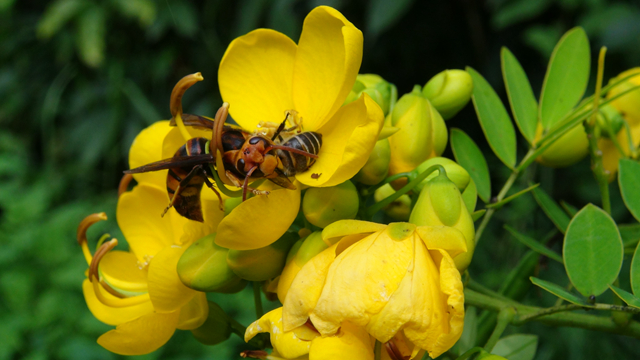Plos Biology:中美科学家合作破解蜜蜂语音报警信号
2016年3月25日,国际著名学术杂志《PLOS GENEtics》上在线发表中国科学院西双版纳热带植物园化学生态研究组研究员谭垦领导的研究团队与美国加州大学James Nieh博士合作的题为“Honey Bee Inhibitory Signaling Is Tuned to Threat Severity and Can Act as a Colony Alarm Signal ”的研究成果。研究人员利用胡蜂-蜜蜂这个系统对东方蜜蜂(Apis cerana)的负反馈机制进行了详尽的研究。谭垦研究员为论文共同第一作者和共同通讯作者,James Nieh博士为论文另一共同通讯作者。
蜜蜂通过“舞蹈语言”的形式将食物的方位、距离等信息传递给同伴。舞蹈由外出寻找食物的侦察蜂引导,当遭遇危险的采集蜂回巢时会触发负反馈机制,即蜜蜂舞蹈的停止信号(stop signals)。停止信号由发送者用头撞击接收者的身体,并发出短促语音,收到这个信号的蜜蜂会减少招募同伴去危险的地方。那么当遭遇不同程度的危险时,蜜蜂的停止信号能否精确编码不同的危险信息?
胡蜂是蜜蜂的天敌,他们在花上和蜂箱门口捕捉蜜蜂。其中体型最大的金环胡蜂(Vespa mandarinia)最危险,他们能攻陷蜜蜂蜂巢,并将蜜蜂幼虫、储存的食物等搬回自己巢穴喂养自己的幼虫;凹吻胡蜂(Vespa velutina)体型较小,危险程度相对较低但最常见。因此胡蜂-蜜蜂这个系统是研究蜜蜂能否解码危险信号的理想模型。
研究人员利用胡蜂-蜜蜂这个系统对东方蜜蜂(Apis cerana)的负反馈机制进行了详尽的研究。结果表明与胡蜂同域生长的本土蜜蜂进化出了警告同伴有危险的语音报警信号。该信号由简单的脉冲振动组成,其中的频率代表危险程度;持续时间代表危险的类型。信号接收者会根据编码的危险程度及危险类型做出相应的反应:停止招募同伴去危险的地方或是留在安全的巢内。这是首次在脊椎动物(如鸟类和灵长类)外发现如此精确的语音报警信号。这个信号与蜜蜂精巧的舞蹈语言相匹配,构成了舞蹈的触发-表达-报警-停止的完整过程。

图:胡蜂在花上捕食蜜蜂

图:胡蜂在蜂巢门口捕食蜜蜂
原文链接:
Honey Bee Inhibitory Signaling Is Tuned to Threat Severity and Can Act as a Colony Alarm Signal
原文摘要:
Alarm communication is a key adaptation that helps social groups resist predation and rally defenses. In Asia, the world’s largest hornet, Vespa mandarinia, and the smaller hornet, Vespa velutina, prey upon foragers and nests of the Asian honey bee, Apis cerana. We attacked foragers and colony nest entrances with these predators and provide the first evidence, in social insects, of an alarm signal that encodes graded danger and attack context. We show that, likeApis melLifera, A. cerana possesses a vibrational “stop signal,” which can be triggered by predator attacks upon foragers and inhibits waggle dancing. Large hornet attacks were more dangerous and resulted in higher bee mortality. Per attack at the colony level, large hornets elicited more stop signals than small hornets. Unexpectedly, stop signals elicited by large hornets (SS large hornet) had a significantly higher vibrational fundamental frequency than those elicited by small hornets (SS small hornet) and were more effective at inhibiting waggle dancing. Stop signals resulting from attacks upon the nest entrance (SS nest) were produced by foragers and guards and were significantly longer in pulse duration than stop signals elicited by attacks upon foragers (SS forager). Unlike SS forager, SS nest were targeted at dancing and non-dancing foragers and had the common effect, tuned to hornet threat level, of inhibiting bee departures from the safe interior of the nest. Meanwhile, nest defenders were triggered by the bee alarm pheromone and live hornet presence to heat-ball the hornet. In A. cerana, sophisticated recruitment communication that encodes food location, the waggle dance, is therefore matched with an inhibitory/alarm signal that encodes information about the context of danger and its threat level.
DOI: 10.1371/journal.pbio.1002423
作者:谭垦、James Nieh

